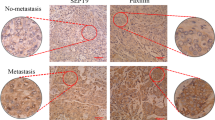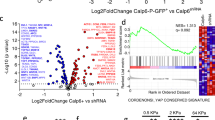Abstract
Overexpression of the c-Jun proto-oncogene in MCF7 breast cancer cells results in a variety of phenotype changes related to malignant progression including increased motility and invasion. Concurrent with these phenotypic effects are changes in the expression of multiple gene targets. We previously demonstrated that expression of the SPARC/osteonectin gene, while undetectable in the MCF7 cell line, is highly induced in response to stable c-Jun overexpression (c-Jun/MCF7). Because the SPARC gene product is associated with tumor cell invasion in a variety of different cancers, we have examined its role in mediating the phenotypic changes induced by c-Jun in MCF7 cells. We found that antisense mediated suppression of SPARC dramatically inhibits both motility and invasion in this c-Jun/MCF7 model. In contrast, stable overexpression of SPARC in the parental MCF7 cell line is not sufficient to stimulate cell motility or invasion. Examination of the promoter region of the human SPARC gene reveals three non-canonical AP-1 sites. We demonstrate that one of these sites binds c-Jun/Fra1 heterodimers in vitro, but that this and the other AP-1 like sites are dispensable with respect to c-Jun stimulated SPARC promoter activation. Deletion analysis identified a region between −120 and −70 as a c-Jun responsive element sufficient to induce maximal promoter activation. This region does not contain any AP-1 sites but does mediate binding by SP1 ‘like’ complexes. Furthermore, this region is necessary for SP1/SP3 responsiveness in Drosophila SL2 cells. These results demonstrate that SPARC plays an important role in stimulating motility and the invasive behavior of c-Jun/MCF7 cells and that SPARC promoter activation by c-Jun appears to occur through an indirect mechanism.
This is a preview of subscription content, access via your institution
Access options
Subscribe to this journal
Receive 50 print issues and online access
$259.00 per year
only $5.18 per issue
Buy this article
- Purchase on Springer Link
- Instant access to full article PDF
Prices may be subject to local taxes which are calculated during checkout











Similar content being viewed by others
References
Bamberger AM, Methner C, Lisboa BW, Stadtler C, Schulte HM, Loning T, Milde-Langosch K . 1999 Int. J. Cancer 84: 533–538
Basso J, Briggs J, Findlay C, Bos T . 2000 Oncogene 19: 4876–4885
Bellahcene A, Castronovo V . 1995 Am. J. Pathol. 146: 95–100
Benbrook DM, Jones NC . 1990 Oncogene 5: 295–302
Bengal E, Ransone L, Scharfmann R, Dwarki VJ, Tapscott SJ, Weintraub H, Verma IM . 1992 Cell 68: 507–519
Bergers G, Graninger P, Braselmann S, Wrighton C, Busslinger M . 1995 Mol. Cell. Biol. 15: 3748–3758
Bos TJ, Margiotta P, Bush L, Wasilenko W . 1999 Int. J. Cancer 81: 404–410
Bradshaw AD, Sage EH . 2001 J. Clin. Invest. 107: 1049–1054
Brekken RA, Sage EH . 2001 Matrix Biol. 19: 816–827
Brown TJ, Shaw PA, Karp X, Huynh MH, Begley H, Ringuette MJ . 1999 Gynecol. Oncol. 75: 25–33
Chen BK, Chang WC . 2000 Proc. Natl. Acad. Sci. USA 97: 10406–10411
Chinenov Y, Kerppola TK . 2001 Oncogene 20: 2438–2452
Colombo MP, Ferrari G, Biondi G, Galasso D, Howe CC, Parmiani G . 1991 Eur. J. Cancer 27: 58–62
Courey AJ, Tjian R . 1988 Cell 55: 887–898
De Cesare D, Vallone D, Caracciolo A, Sassone-Corsi P, Nerlov C, Verde P . 1995 Oncogene 11: 365–376
Dennig J, Beato M, Suske G . 1996 EMBO J. 15: 5659–5667
Gee JM, Barroso AF, Ellis IO, Robertson JF, Nicholson RI . 2000 Int. J. Cancer 89: 177–186
Gee JM, Ellis IO, Robertson JF, Willsher P, McClelland RA, Hewitt KN, Blamey RW, Nicholson RI . 1995 Int. J. Cancer 64: 269–273
Gilles C, Bassuk JA, Pulyaeva H, Sage EH, Foidart JM, Thompson EW . 1998 Cancer Res. 58: 5529–5536
Graham JD, Balleine RL, Milliken JS, Bilous AM, Clarke CL . 1997 Eur. J. Cancer 33: 1654–1660
Greenwood JA, Murphy-Ullrich JE . 1998 Microsc. Res. Tech. 43: 420–432
Hadman M, Gabos L, Loo M, Sehgal A, Bos TJ . 1996 Oncogene 12: 135–142
Hadman M, Loo M, Bos TJ . 1993 Oncogene 8: 1895–1903
Horne GM, Anderson JJ, Tiniakos DG, McIntosh GG, Thomas MD, Angus B, Henry JA, Lennard TW, Horne CH . 1996 Br. J. Cancer 73: 29–35
Jacob K, Webber M, Benayahu D, Kleinman HK . 1999 Cancer Res. 59: 4453–4457
Jiang Y, Goldberg ID, Shi YE . 2002 Oncogene 21: 2245–2252
Kardassis D, Papakosta P, Pardali K, Moustakas A . 1999 J. Biol. Chem. 274: 29572–29581
Kato Y, Frankenne F, Noel A, Sakai N, Nagashima Y, Koshika S, Miyazaki K, Foidart JM . 2000 Pathol. Oncol. Res. 6: 24–26
Kim Y, Park, Lee, Ko, Yang . 1998 J. Korean Med. Sci. 13: 652–657
Kobierski LA, Chu HM, Tan Y, Comb MJ . 1991 Proc. Natl. Acad. Sci. USA 88: 10222–10226
Kraemer M, Tournaire R, Dejong V, Montreau N, Briane D, Derbin C, Binetruy B . 1999 Cell Growth Differ. 10: 193–200
Ledda F, Bravo AI, Adris S, Bover L, Mordoh J, Podhajcer OL . 1997a J. Invest. Dermatol. 108: 210–214
Ledda MF, Adris S, Bravo AI, Kairiyama C, Bover L, Chernajovsky Y, Mordoh J, Podhajcer OL . 1997b Nat. Med. 3: 171–176
Majello B, De Luca P, Lania L . 1997 J. Biol. Chem. 272: 4021–4026
Mettouchi A, Cabon F, Montreau N, Vernier P, Mercier G, Blangy D, Tricoire H, Vigier P, Binetruy B . 1994 EMBO J. 13: 5668–5678
Milde-Langosch K, Bamberger AM, Methner C, Rieck G, Loning T . 2000 Int. J. Cancer 87: 468–472
Mok SC, Chan WY, Wong KK, Muto MG, Berkowitz RS . 1996 Oncogene 12: 1895–1901
Motamed K . 1999 Int. J. Biochem. Cell Biol. 31: 1363–1366
Nishitani J, Nishinaka T, Cheng CH, Rong W, Yokoyama KK, Chiu R . 1999 J. Biol. Chem. 274: 5454–5461
Porte H, Chastre E, Prevot S, Nordlinger B, Empereur S, Basset P, Chambon P, Gespach C . 1995 Int. J. Cancer 64: 70–75
Porte H, Triboulet JP, Kotelevets L, Carrat F, Prevot S, Nordlinger B, DiGioia Y, Wurtz A, Comoglio P, Gespach C, Chastre E . 1998 Clin. Cancer Res. 4: 1375–1382
Porter PL, Sage EH, Lane TF, Funk SE, Gown AM . 1995 J. Histochem. Cytochem. 43: 791–800
Reed MJ, Sage EH . 1996 Curr. Top. Microbiol. Immunol. 213: 81–94
Rinehart-Kim J, Johnston M, Birrer M, Bos T . 2000 Int. J. Cancer 88: 180–190
Rosenblatt S, Bassuk JA, Alpers CE, Sage EH, Timpl R, Preissner KT . 1997 Biochem. J. 324: 311–319
Ryseck RP, Bravo R . 1991 Oncogene 6: 533–542
Sambrook J, Fritsch EF, Manatis T . 1989 A Laboratory Manual New York: Cold Spring Harbor Laboratory Press
Schneider I . 1972 J. Embryol. Exp. Morphol. 27: 353–365
Schüle R, Rangarajan P, Kliewer S, Ransone LJ, Bolado J, Yang N, Verma IM, Evans RM . 1990 Cell 62: 1217–1226
Shaulian E, Karin M . 2001 Oncogene 20: 2390–2400
Smith LM, Wise SC, Hendricks DT, Sabichi AL, Bos T, Reddy P, Brown PH, Birrer MJ . 1999 Oncogene 18: 6063–6070
Stein B, Baldwin JAS, Ballard DW, Greene WC, Angel P, Herrlich P . 1993a EMBO J. 12: 3879–3891
Stein B, Cogswell PC, Baldwin JAS . 1993b Mol. Cell. Biol. 13: 3964–3974
Sturm RA, Satyamoorthy K, Meier F, Gardiner BB, Smit DJ, Vaidya B, Herlyn M . 2002 Cancer Res. 62: 226–232
Thomas R, True LD, Bassuk JA, Lange PH, Vessella RL . 2000 Clin. Cancer Res. 6: 1140–1149
Tiniakos DG, Scott LE, Corbett IP, Piggott NH, Horne CH . 1994 J. Pathol. 172: 19–26
Touray M, Ryan F, Jaggi R, Martin F . 1991 Oncogene 6: 1227–1234
Ubeda M, Vallejo M, Habener JF . 1999 Mol. Cell. Biol. 19: 7589–7599
van Dam H, Castellazzi M . 2001 Oncogene 20: 2453–2464
Vial E, Castellazzi M . 2000 Oncogene 19: 1772–1782
Vial E, Perez S, Castellazzi M . 2000 Oncogene 19: 5020–5029
Vogt PK . 2001 Oncogene 20: 2365–2377
Yamanaka M, Kanda K, Li NC, Fukumori T, Oka N, Kanayama HO, Kagawa S . 2001 J. Urol. 166: 2495–2499
Yan Q, Sage EH . 1999 J. Histochem. Cytochem. 47: 1495–1506
Yang-Yen H-F, Chambard J-C, Sun Y-L, Smeal T, Schmidt TJ, Drouin J, Karin M . 1990 Cell 62: 1205–1215
Yang-Yen H-F, Zhang X-k, Graupner G, Tzukerman M, Sakamoto B, Karin M, Pfahl M . 1991 The New Biologist 3: 1206–1219
Yiu GK, Chan WY, Ng SW, Chan PS, Cheung KK, Berkowitz RS, Mok SC . 2001 Am. J. Pathol. 159: 609–622
Zajchowski DA, Bartholdi MF, Gong Y, Webster L, Liu HL, Munishkin A, Beauheim C, Harvey S, Ethier SP, Johnson PH . 2001 Cancer Res. 61: 5168–5178
Acknowledgements
We thank Dr Janet Rinehart-Kim for technical assistance with the motility and invasion assays and for critical review of this manuscript. We are grateful to Dr Salvatore Oliviero for the gift of the pAC expression vectors. This work was supported in part by grants to TJ Bos and NIH R01CA51982 and the Thomas F and Kate Miller Jeffress Foundation and a grant from the Association pour la Recherche contre le Canter (ARC contract no 4398) to M Castellazzi.
Author information
Authors and Affiliations
Corresponding author
Rights and permissions
About this article
Cite this article
Briggs, J., Chamboredon, S., Castellazzi, M. et al. Transcriptional upregulation of SPARC, in response to c-Jun overexpression, contributes to increased motility and invasion of MCF7 breast cancer cells. Oncogene 21, 7077–7091 (2002). https://doi.org/10.1038/sj.onc.1205857
Received:
Revised:
Accepted:
Published:
Issue Date:
DOI: https://doi.org/10.1038/sj.onc.1205857
Keywords
This article is cited by
-
Diosgenin restores memory function via SPARC-driven axonal growth from the hippocampus to the PFC in Alzheimer’s disease model mice
Molecular Psychiatry (2023)
-
Growth hormone/IGF-I-dependent signaling restores decreased expression of the myokine SPARC in aged skeletal muscle
Journal of Molecular Medicine (2022)
-
Transcription factor Runx2 changes the expression of some matricellular proteins in metastatic breast cancer cells
Molecular Biology Reports (2022)
-
Association of SPARC gene polymorphisms rs3210714 and rs7719521 with VEGF expression and utility of Nottingham Prognostic Index scoring in breast cancer in a sample of Egyptian women
Molecular Biology Reports (2018)
-
Regulation of Fibulin-2 Gene Expression by Integrin α3β1 Contributes to the Invasive Phenotype of Transformed Keratinocytes
Journal of Investigative Dermatology (2014)



